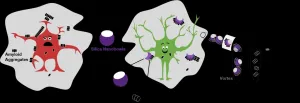Nanoparticles help untangle Alzheimer's disease amyloid beta plaques
New research shows that the protein that causes Alzheimer's disease's hallmark brain plaques clings to certain bowl-shaped nanoparticles, allowing researchers to better understand the disease and potentially providing a targeted therapeutic
2021-02-26
(Press-News.org) ROCKVILLE, MD - Scientists are still a long way from being able to treat Alzheimer's Disease, in part because the protein aggregates that can become brain plaques, a hallmark of the disease, are hard to study. The plaques are caused by the amyloid beta protein, which gets misshapen and tangled in the brain. To study these protein aggregates in tissue samples, researchers often have to use techniques that can further disrupt them, making it difficult to figure out what's going on. But new research by Vrinda Sant, a graduate student, and Madhura Som, a recent PhD graduate, in the lab of Ratnesh Lal at the University of California, San Diego, provides a new technique for studying amyloid beta and could be useful in future Alzheimer's treatments. Sant and her colleagues will present their research on Friday, February 26 at the 65th Annual Meeting of the Biophysical Society.
Scientists have been studying the possibility of using nanoparticles, ultra-small structures that can be coated in therapeutics, to provide targeted treatments for a number of diseases. There are several potential applications for nanoparticles, such as coating them with chemotherapy agents and targeting them to a tumor for cancer treatment without toxic side effects for the rest of the body. Sant began researching bowl-shaped nanoparticles, which she calls "nanobowls," as a potential way to deliver treatments for Alzheimer's Disease.
Sant expected to have to coat the nanobowls in some kind of pharmaceutical in order to have them alleviate the amyloid beta protein plaques that contribute to Alzheimer's. But the amyloid beta proteins clung to the nanobowls even when they were just coated in a lipid-polymer without pharmaceuticals added, allowing the scientists to remove the toxic protein aggregates from the cells. "We were surprised to find that the nanobowls were therapeutic themselves," Sant says.
Sant says while using nanobowls as therapeutics for Alzheimer's Disease can be a potential application, it currently serves scientists who want to better understand the amyloid beta aggregates. In their recent research, Sant and team found that multiple forms of amyloid beta aggregates co-exist and not all forms directly convert into amyloid plaques, confirming what had been a hypothesis in the field. The research team is now working on using nanobowls to extract and further study amyloid beta protein aggregates. With amyloid beta being implicated in neurodegenerative diseases, cancer and cardiovascular conditions, nanobowls have potential for a range of diagnostics and treatments.
INFORMATION:
[Attachments] See images for this press release:

ELSE PRESS RELEASES FROM THIS DATE:
2021-02-26
Our use of social media, specifically our efforts to maximize "likes," follows a pattern of "reward learning," concludes a new study by an international team of scientists. Its findings, which appear in the journal Nature Communications, reveal parallels with the behavior of animals, such as rats, in seeking food rewards.
"These results establish that social media engagement follows basic, cross-species principles of reward learning," explains David Amodio, a professor at New York University and the University of Amsterdam and one of the paper's authors. "These findings may help us understand why social media comes to dominate daily life for many people and provide clues, borrowed from research on reward learning and addiction, to how troubling online engagement may ...
2021-02-26
Chemical engineering researchers have developed a new catalyst that significantly increases yield in styrene manufacturing, while simultaneously reducing energy use and greenhouse gas emissions.
"Styrene is a synthetic chemical that is used to make a variety of plastics, resins and other materials," says Fanxing Li, corresponding author of the work and Alcoa Professor of Chemical Engineering at North Carolina State University. "Because it is in such widespread use, we are pleased that we could develop a technology that is cost effective and will reduce the environmental impact of styrene manufacturing." Industry estimates ...
2021-02-26
The koala retrovirus (KoRV) is a virus which, like other retroviruses such as HIV, inserts itself into the DNA of an infected cell. At some point in the past 50,000 years, KoRV has infected the egg or sperm cells of koalas, leading to offspring that carry the retrovirus in every cell in their body. The entire koala population of Queensland and New South Wales in Australia now carry copies of KoRV in their genome. All animals, including humans, have gone through similar "germ line" infections by retroviruses at some point in their evolutionary history and contain many ancient retroviruses in their genomes. These retroviruses have, over millions of years, mutated into degraded, inactive forms that are no longer harmful to the host. Since in most animal ...
2021-02-26
NARRAGANSETT, R.I. - February 26, 2021 - A team of researchers from the University of Rhode Island's END ...
2021-02-26
When a muscle grows, because its owner is still growing too or has started exercising regularly, some of the stem cells in this muscle develop into new muscle cells. The same thing happens when an injured muscle starts to heal. At the same time, however, the muscle stem cells must produce further stem cells - i.e., renew themselves - as their supply would otherwise be depleted very quickly. This requires that the cells involved in muscle growth communicate with each other.
Muscle growth is regulated by the Notch signaling pathway
Two years ago, a team of researchers led by Professor Carmen Birchmeier, head of the Developmental Biology/Signal Transduction ...
2021-02-26
A new study shows that a widespread decline in abundance of emergent insects - whose immature stages develop in lakes and streams while the adults live on land - can help to explain the alarming decline in abundance and diversity of aerial insectivorous birds (i.e. preying on flying insects) across the USA. In turn, the decline in emergent insects appears to be driven by human disturbance and pollution of water bodies, especially in streams. This study, published in END ...
2021-02-26
Who would have thought that a small basic compound like vitamin B6 in the banana or fish you had this morning may be key to your body's robust response against COVID-19?
Studies have so far explored the benefits of vitamins D and C and minerals like zinc and magnesium in fortifying immune response against COVID-19. But research on vitamin B6 has been mostly missing. Food scientist END ...
2021-02-26
HDL cholesterol (high-density lipoprotein cholesterol) or good cholesterol is associated with a decreased risk of cardiovascular disease as it transports cholesterol deposited in the arteries to the liver to be eliminated. This contrasts with the so-called bad cholesterol, LDL (low-density lipoprotein cholesterol), which causes cholesterol to accumulate in the arteries and increases cardiovascular risk. Although drugs that lower bad cholesterol reduce cardiovascular risk, those that raise good cholesterol have not proven effective in reducing the risk of heart disease. This paradox has called into question the ...
2021-02-26
Whilst the nation has taken to washing its hands regularly since the start of the pandemic, other individual behaviours, such as cleaning and disinfecting surfaces or social distancing within the home, have proved harder to stick, say the researchers behind the behaviour change website 'Germ Defence'.
In their new study, published today (Friday 26 February 2021) in the Journal of Medical Internet Research, psychologists from the universities of Bath, Bristol and Southampton, warn of the continuing risks of household transmission of COVID-19 and the ongoing importance of breaking chains of transmission now and in the future.
Their research analysed user data of the ...
2021-02-26
Treating critically ill COVID-19 patients with drugs typically used for rheumatoid arthritis may significantly improve survival, a landmark study has found.
The findings, which were announced in January and have now been peer-reviewed and published in the New England Journal of Medicine, come from the REMAP-CAP trial, which evaluates the effect of treatments on a combination of survival and length of time patients need support in an intensive care unit (ICU).
Initial findings reported in November showed that tocilizumab, a drug used to treat arthritis, was likely to improve outcomes among critically ill COVID-19 ...
LAST 30 PRESS RELEASES:
[Press-News.org] Nanoparticles help untangle Alzheimer's disease amyloid beta plaques
New research shows that the protein that causes Alzheimer's disease's hallmark brain plaques clings to certain bowl-shaped nanoparticles, allowing researchers to better understand the disease and potentially providing a targeted therapeutic



